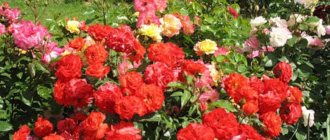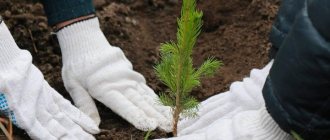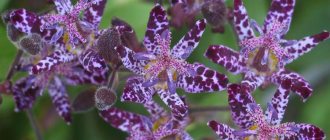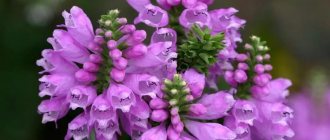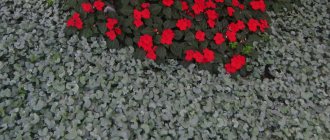Snowdrops are one of the first flowers to appear in our gardens. As the name suggests, they are actually capable of breaking through remaining snow.
Snowdrops are found in the wild in Poland, Russia and much of Europe. However, for a long time they were threatened with complete extinction, which is why wild snowdrops are in the Red Book. However, we can plant garden snowdrops.
Snowdrops are the true harbingers of spring and not only do they look good, but they also smell nice and provide the bees with their first pollen. The structure of their flower protects it from frost, and its milky white color gives rise to the scientific name of snowdrops - galanthus - translated from Greek "milk flower", the second part of the name - nivalis - meaning "snowy".
Flower petals are divided into internal and external and differ in length. Heart-shaped green spots ending in inner flower petals add to the charm of snowdrops.
Snowdrop leaves are narrow, saber-shaped, gray-green, usually two to four grow from one bulb.
TOP 5 best types of snowdrops suitable for growing in the middle zone and in the Moscow region
The most popular among all species for growing in the Moscow region and to the north is the snow-white snowdrop and its varieties.
Snowdrop white
1st PLACE: Snow-white snowdrop, or snow-white galanthus / Galanthus nivalis
Snow-white snowdrop, fortunately, is not yet listed in the Red Book of Russia. It was called “snow white” by the Swedish scientist Carl Linnaeus back in 1735. In culture, this is the most stable species.
The snowdrop snowdrop has a round, fleshy bulb with a diameter of 1-3 cm. The flowers of the snowdrop are fragrant, bell-shaped, 2-3 cm long, drooping, white with a green spot at the ends of the leaves.
The most popular variety of snow-white snowdrop is Flore Pleno , with large double flowers:
Flore Pleno cultivar has been known since 1703
Varieties of snowdrop white:
with simple flowers:
Snowdrop Viridapice - What makes this snowdrop special is that its outer petals have green tips, whereas usually only the inner petals have a green marking. Peduncles are 15-20 cm high. There are various spelling options for the name of this snowdrop.
Snowdrop snowdrop Maximus (Imperial Group) - there are difficulties with this variety, since even those who sell it are not sure that they have this particular variety for sale; perhaps the original cultivar as such no longer exists. Plants sold under the name Maximus have rounded white outer petals, inner petals with green markings, and the flowers themselves are medium in size.
with double flowers:
Snowdrop Flore Pleno (Double Group) - video above
2nd PLACE: Elveza snowdrop, Elveza galanthus (Galanthus elwesii)
The second most famous species of snowdrop is the snowdrop, or Galanthus Elveza, a plant native to the mountain meadows and forests of Southeastern Europe. It blooms earlier than the snow-white snowdrop, and the flowering period is quite long - 3-4 weeks. It is also resistant to cultivation and has many ornamental cultivars.
This snowdrop is slightly larger than the previous one: it reaches a height of 20-25 cm. The leaves are from 1.5 to 3 cm wide, gray, sometimes with a grayish hood at the top. The flowers of the Elveza snowdrop are white, large - up to 4-5 cm in length with green spots on the inner tepals, spherical and fragrant.
The snowdrop received its specific name in memory of the famous English botanist Henry John Elvis (Elvis), who discovered it in Turkey in the 70s of the 19th century.
Snowdrop Elveza, trade name often spelled Snowdrop Elvis
Snowdrop Elweza Comet - considered one of the best varieties of Galanthus elwesii var. monostictus. Snowdrop with a large flower on a long arched peduncle; green markings on inner petals.
3rd PLACE: Snowdrop folded, Galanthus folded / Galanthus plicatus
The third most popular species of snowdrop is the folded snowdrop, native to the mountain meadows and forests of South-Eastern Europe.
Almost all bouquets of snowdrops sold in Moscow in April are cut flowers of the folded snowdrop. Take care of nature and do not buy snowdrops from nature destroyers!
This is a species with wider bluish leaves than the white snowdrop. Peduncles are 10–20 cm high. The flowers are quite large: up to 4 cm long. Blooms in early to mid-April.
Snowdrop folded
The species reproduces vegetatively and by seeds, and self-sows.
It is actively used in breeding, for example, Galanthus plicatus x nivalis - a hybrid with bluish linear leaves and large (up to 4 cm long) flowers on peduncles up to 20 cm high. Unfortunately, it is rarely grown.
4th PLACE: Broad-leaved snowdrop, broad-leaved galanthus / Galanthus platyphyllus
Snowdrop broadleaf is a resistant species. One of the most promising snowdrops for the northern zone.
The height of the peduncles during flowering is 10–15 (up to 20) cm. The leaves are up to 4 cm wide (hence the name of the species), green. Flowers are 1–2 cm long. Blooms in mid-April - early May, up to 20 days.
Snowdrop broadleaf reproduces vegetatively and by seeds.
In the Red Book of Russia the species is listed as rare, having a limited range. The species is included in the Red Book of the Republic of Alanya.
Snowdrop latifolia
5th PLACE: Snowdrop Voronova, Galanthus Voronowii / Galanthus woronowii
Voronov's snowdrop is endemic to the Caucasus, where it grows along the edges of deciduous forests. Named in honor of the Russian botanist Yuri Voronov (1874-1931). Unfortunately, in central Russia, Voronov’s snowdrop is the least resistant of all the species represented in the top five.
The bulb is oval with a diameter of 2-2.5 cm. The height of the peduncles is 10-15 cm. The leaves are bright green, lanceolate (in the buds one leaf covers the other). Fragrant flowers of medium size, 3–4 cm in diameter.
In nature it blooms in late February-early March.
It reproduces both vegetatively and by seeds.
Snowdrop Voronova
Snowdrops in the garden landscape
Snowdrops are very decorative in large groups, not only in rock gardens, but also in the form of “carpets” under trees and shrubs in light partial shade, as well as in the form of white lawns among the lawn. Miniature bouquets of snowdrops can stand in water for a long time, and with a simple arrangement in crystal vases they look attractive and expressive.
It is advisable to plant snowdrops together in small groups of 10-30 pieces. The disadvantage of these flowers is the early death of the above-ground parts. But it can easily be overcome in a flower garden, where it is preferable to keep plants that are tolerant of shading and do not tolerate drying out during the dormant period.
Snowdrops are planted between bushes of slow-growing perennials with spreading leaves, such as hostas and peonies. They also successfully complement late-growing perennials. The main thing is that snowdrops are illuminated during the growing season for at least part of the day.
To imitate natural corners of nature in gardens and parks, snowdrops are often planted under shrubs and deciduous trees, placing them on the illuminated side. In the resting stage, they can tolerate any shade. It is better not to rake leaves that have fallen from trees: plants easily break through them in the spring, and they do not interfere with them at all. In addition, rotted snowdrop leaves are a good natural fertilizer, and, in addition, they retain increased moisture in the top layer of soil. If the leaves get in the way for some reason, they should be removed in the fall so as not to damage the regrown plants in the spring.
Snowdrops are recommended to be planted to create early flowering groups in the shade in combination with scillas, corydalis, lungwort, and primrose. You can also use snowdrops in mixed plantings with medium-sized and tall late-growing perennials: ferns, hosta, peonies.
Low-resistant and rare species, many of which are listed in the Red Book
Snowdrop angustifolius / Galanthus angustifolius
Snowdrop angustifolia is endemic to Russia, grows naturally in the regions of Central and Eastern Ciscaucasia, is listed in the Red Book and is protected in two reserves of the North Ossetian and Kabardino-Balkarian republics.
The narrow-leaved species is one of the smallest snowdrops and is characterized by slow growth.
Snowdrop angustifolia
Caucasian snowdrop, Caucasian galanthus / Galanthus caucasicus
Caucasian snowdrop is a rare species with a limited range: endemic to the Caucasus. Suffers from massive flower picking and digging. It is successfully grown in 8 botanical gardens of the Russian Federation.
The species is distinguished by a rather high peduncle - 20 cm high. The leaves have two flat leaves covered with a waxy coating. The flowers are white, medium in size, up to 3 cm long.
Caucasian snowdrop
It blooms in the first half of April, for two weeks.
Propagated vegetatively and by seeds. The species is moderately resistant in cultivation and does not tolerate frost well.
Kabardian snowdrop, Kabardian galanthus / Galanthus cabardensis, Galanthus lagodechianus
Kabardian snowdrop is included in the Red Book of the Chechen Republic.
Plant up to 7–15 cm tall. The flowers are medium-sized - up to 3 cm long.
Blooms in early April. Reproduces vegetatively.
The species is quite stable, but rare in culture.
Kabardian snowdrop
Greek snowdrop, Greek galanthus / Galanthus graecus
The Greek snowdrop is rare in our country; it is a medium-resistant species, native to the mountains of Asia Minor.
Peduncles up to 10 cm high; there are green spots at the base of the inner perianth lobes. Blooms in early April.
Reproduces vegetatively.
Icarian snowdrop, Galanthus ikariae
The species is similar to Voronov's snowdrop, native to Asia Minor, an island in the Aegean Sea. Not stable in middle zone culture.
The plants are small, the flowers are 2–2.5 cm long. There are green spots at the ends of the inner perianth segments.
Snowdrop icarian
Bortkevich's snowdrop / Galanthus bortkewitschianus, Galanthus alpinus var. bortkewitschianus
They grow naturally in the mountains of the North Caucasus and are classified as endangered species in the Red Book. The natural range is limited to the mountains of Kabardino-Balkaria.
The peculiarity of the species is only vegetative reproduction; a larger population cannot form in nature.
Bortkevich's snowdrop
Galanthus diseases and pests
Among the pests, galanthus is attacked by slugs, cutworm butterfly caterpillars, and bulb nematodes. A transplant will help against nematodes. All diseased bulbs must be destroyed. Disinfect the rest by placing them in a manganese solution for several hours before transplanting. Galanthus suffers from chlorosis and gray mold. Fungal diseases can be caused by damp and warm weather. The affected parts must be cut off and the plant treated with fungicides. Chlorosis occurs from stagnation of water in the soil. Proper watering and good drainage will help here.
New classification of snowdrops
Previously, all snowdrops were classified by species. But in February 2011, Hanneke van Dijk from the Netherlands described a classification of snowdrops, according to which they are all divided into 10 groups. The classification is based on the color and shape of the flower, but unfortunately not on the characteristics of the foliage.
The classification is described in the book by Hanneke van Dyck Galantomania / GALANTHOMANIA. The book contains a complete description of all the avid snowdrop collectors who reveal their secrets. The book contains information about all types of snowdrops and many varieties that are now available, unfortunately mainly in the EU. More than 500 photographs illustrate the beauty of snowdrops. The book is bilingual: Dutch/English.
Mr. Summer Resident informs: several rules for growing snowdrops
Primrose lovers who have galanthus in their plots support the plant throughout its life cycle. Things to remember to achieve good flowering:
- The plant should not be planted in areas that dry out quickly; there will be few flowers. In low-lying areas where melt water accumulates, the bulbs will rot.
- After germination, the plant needs to be watered; if there is little melt water, there is no rain for a long time.
- It is better to divide the hummocks or separate the children in the summer, when the snowdrop is resting. After autumn transplantation, the bulbs do not gain full strength and do not lay buds. In spring, the plants are also not disturbed.
- Only cut off yellowed leaves when the growing season ends. Greens provide nutrition to new bulbs.
- During winters with little snow, snowdrops are covered with peat or light compost to prevent the soil from freezing. They do not make heavy coverings over galanthus.
- During the flowering period, fertilizing should be phosphate. The use of others is undesirable. From excess nitrogen, leaves form abundantly, and the plant begins to rot.
When favorable conditions are created, the flower will develop normally and produce abundant color arrows every year.
Snowdrops do not require constant care. When the planting site is chosen well, the plant takes root well and will reproduce on its own. Every spring there will be more buds.
You can achieve gradual flowering if you plant several types of galanthus, for example, Elveza, Snow White, and Folded. They will delight you for a long time with their delicate buds from the very beginning of spring until the snow melts.
More interesting snowdrop cultivars, most of which, unfortunately, are inaccessible to us
Snowdrop Dionysus is a double hybrid of the folded snowdrop (G. plicatus). Large flowers have green spots on the inner segments. Blooms in March and April, 15-20 cm high.
Snowdrop Hippolyta is a snowdrop with green flowers and a small white edge. 10-15 cm high. Unfortunately, the variety is not readily available for purchase outside the EU.
Snowdrop S. Arnott (Imperial Group) has beautiful convex outer petals that are white with green markings on the inner petals. The flower smells like honey. The plant is 30 cm high. The variety is rare outside the EU.
Galanthus Bill Bishop is a large snowdrop from the "Mighty Atom" group with long outer petals and a distinct inverted V-shaped marking on the inner flower segments. Flowering early.
Snowdrop White Dream - The snowdrop "White Dream" is easily recognizable: it is one of the snow-white flowers. It blooms late, but very actively.
Snowdrop Snowwhite (Imperial Group) - The snowdrop "Snow White" is a cultivar of the Elveza snowdrop. Outwardly it is no different, but it blooms very profusely and later than the species. This Dutch cultivar should not be confused with "Snow White", an English cultivar from Snowdrop snowdrop.
Merlin snowdrop is a fairly old variety with almost entirely green internal segments. The foliage is thin, gray.
Snowdrop Ailwyn (Double Group) is a rare variety with perfectly close-spaced inner petals with small green markings.
Snowdrop Snowfox with small flowers and wide leaves.
Description of the plant
One beautiful legend talks about an Angel who, with his breath, melted a cold and graceful snowflake, which turned into a delicate flower, which was called a snowdrop. It can be found in the Caucasus, in Europe, Georgia, Azerbaijan, Ukraine, in the west of Asia Minor and in parts bordering it in the spring months. The scientific name of the snowdrop is galanthus, which is translated from Greek as milk flower. Snowdrop inflorescences are milky white and decorated with stripes or a spot of green at the base of the petals.
Galanthus belongs to a type of perennial herbaceous bulbous crops of the Amaryllidaceae family and includes approximately 18 species. The exact number of species has not been established due to disagreements on this issue between botanists.
Galanthus spend a significant part of their life underground in a state of rest, and only with the arrival of spring does nature awaken and the time comes when snowdrops grow. Each bulb produces one flower. The oblong-lanceolate leaves of the plant germinate along with the peduncles and at the time the buds open, they are the same height as them or slightly lower.
Only after the end of flowering do they begin to grow in full force, growing 10−30 cm long and 0.5−3 cm wide. Galanthus leaves are matte and glossy. They can be colored in a variety of shades of green, from light green with a yellow tint to a dark green shade.
Under favorable weather conditions, snowdrops begin to bloom in February with drooping, bell-shaped flowers on long thin stalks. Its perianth consists of 6 petals. Moreover, 3 of them are pure white, oval-shaped and located outside the flower, and the remaining petals are inside it. The inner petals are shorter and have a green or yellow spot at the base. The smell of flowers is subtle, but very pleasant. Snowdrop flowers, or galanthus, live for a very short time - about 30 days.
Snowdrop seeds are black, spherical in shape, and not numerous. They ripen in a fleshy round-shaped box, consisting of three compartments that open along the flaps. Interestingly, ants help spread plants by taking away the seeds. Ants are attracted to the succulent appendage of the seeds.
Planting and caring for snowdrops
There is nothing easier than growing snowdrops. These are perhaps some of the most undemanding crops there are.
They grow well in sun and light shade, and tolerate partial shade. They develop better in sufficiently moist, loose, well-drained and nutritious soil, i.e. Ordinary garden soils are quite suitable for them.
Planting snowdrops
Bulbs
Plants are planted from July to September. There is no need to prepare the place in advance; they can be planted in any flower garden.
For snowdrops, replanting while in bloom is even permissible, but this weakens the bulb.
Snowdrops are propagated by baby bulbs, which are planted in late summer - early autumn (August-September) to a depth of 5-7 cm . Plant snowdrops immediately after dividing, as dried out bulbs do not take root well, while being careful not to break off the roots. Nests of bulbs are planted every 5-6 years, although plants develop well in one place without replanting for a longer period of time. During the season, from 1 to 3 baby onions are formed. To make snowdrops look most impressive, they are immediately planted in small groups of 10-30 pieces.
Snowdrop bulbs before autumn planting
If you need to preserve snowdrop bulbs before planting them in the ground, keep them in damp sand or wrap them in damp sphagnum moss.
Seeds
Snowdrops also reproduce by seeds: seeds that fall out of the capsule are carried by ants, so if there are a lot of ants in the area, after a few years you may find snowdrops in the spring in the most unexpected places. You can propagate snowdrops yourself with freshly collected seeds: the seedlings will bloom in the 4th year. Snowdrops also reproduce by self-seeding, but not particularly actively. In this case, different species can interbreed with each other.
Caring for snowdrops
Ordinary, or rather actually NONE. Fertilizing should be avoided completely, as it stimulates vegetative growth to the detriment of flowering.
Transfer
You can grow such a crop in the same place for quite a long time, but experts advise replanting once every 5–6 years. This is because in 1 year about 2 children are formed on the bulb, and within 6 years quite a lot of them grow, and they begin to feel a lack of nutrients. In this regard, the bulbs should be regularly dug up, divided and planted.
